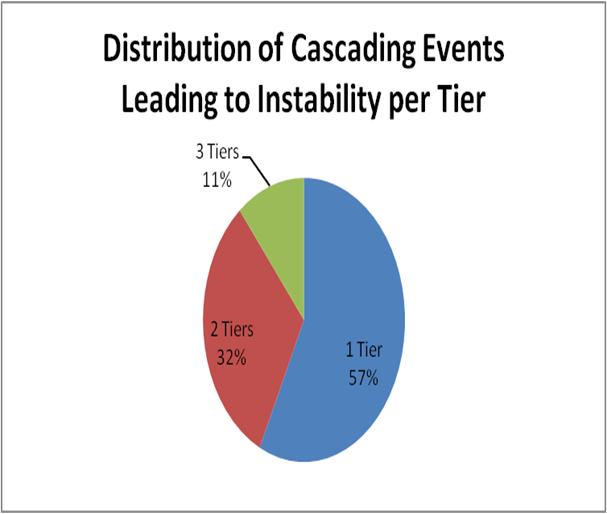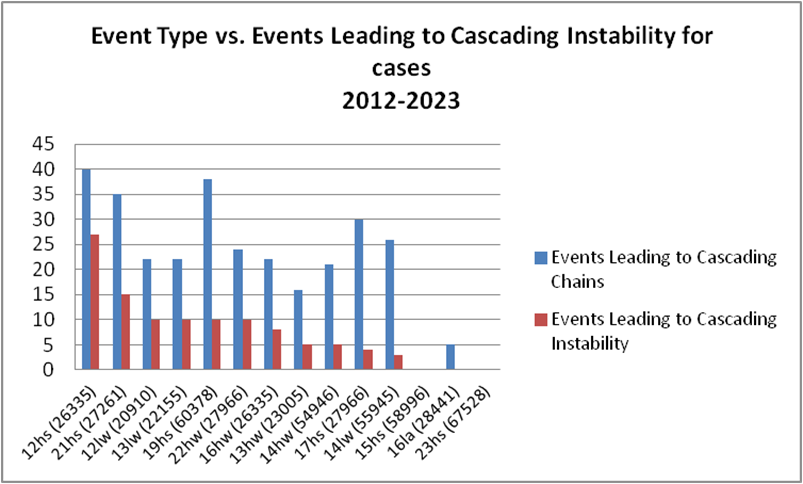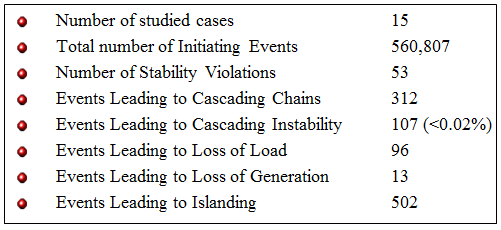Prediction of Cascading Outages – Potential Cascading Modes (PCM)
lly integrated into POM Suite, PCM offers fully automated cascading outages analysis as the steady-state stability phenomenon. A companion, the PCM-TS module is intended for cascading outages analysis from a transient stability perspective. PCM quantifies a power system’s ability to withstand cascading outages due to thermal and/or voltage violations and quickly identifies initiating events that may lead to cascading events. Cascading outages analysis has become a part of NERC-compliance studies and PCM facilitates the analysis of extreme events.
PCM capabilities include:
- Predicting cascading outages by quickly identifying the initiating events
- Automatically identifying tiers in the cascading sequence
- Determining the consequences of the cascading outages
- Ranking cascading outages (e.g., quantifying their impact)
- Being integrated with OPM application
- Visualizing the initiating events, their spread, severity and control actions to prevent the cascades, in order to improve the situational awareness of a utility’s/ISO’s operators
Using PCM
PCM is utilized by the utilities’/ISOs’ in their NERC-compliance studies to assess the system performance following the planning and extreme events. PCM is also incorporated as part of the extensive N-1-1 AC contingency analysis.
PCM-RT is an online cascading analysis tool that is integrated with a utility EMS system and runs 24/7/365. It is a part of ROSE software.
Performing sequential contingency analysis in PCM: steady-state analysis
PCM identifies initiating events that lead to cascading chains caused by the successive tripping of:
- Branches that are overloaded above the threshold;
- Loads due to voltage violations below the threshold; and
- Generators due to voltage violations below/above the threshold.
Fast sequential contingency simulation is used to identify potential cascading modes. Outages are consecutively applied until:
- System fails to solve due to voltage instability;
- Islanding; and
- Thermal/voltage violations are alleviated or drop below the thresholds.
All violated elements are identified during the PCM analysis (even if a violation is below the threshold), but only those violations that exceed the user-defined tripping thresholds are automatically tripped. These tripped elements form cascading tiers. Loss of load and generation is monitored and reported at each cascading tier.
As result of this process, potential cascading modes (PCM) in the power system network are identified.
The PCM analysis results yield the following conclusions:
- The weakest N-1 contingencies form the N-2 initiating events
- The severity of cascading outages in terms of the number of tiers in each cascade, the number of tripped elements on each tier, and the severity of these violations, consequential and nonconsequential load and generation loss.



For online cascading outages analysis, please read ROSE-PCM.
Prevention of the Cascading Outages
If utilized together with OPM, PCM can be used to prevent the cascading outages by optimizing the existing available controls in the electric transmission network. The optimal remedial actions are applied first, after the occurrence of an initiating event, and then at each cascading tier, until the cascading event is mitigated.
When PCM is combined with OPM, the obtained results will provide planning and operations engineers with proper alternative options to prevent the spread of the cascading outages by:
- Identifying initiating events (N-1 and/or N-2 contingencies) that cause the overloads and voltage violations beyond the tripping thresholds.
- Determining the remedial actions in order to alleviate thermal and voltage violations, and apply those remedial actions in order to bring the flows and voltages within the tripping threshold.
- If the remedial actions bring the flows and voltages within the tripping thresholds (e.g., are successful), the cascading stops.
- If the remedial actions identified decrease the violations, but do not bring the flows and voltages within the tripping thresholds, the elements violated beyond the tripping thresholds are tripped, and the next tier in cascading is formed.
Mitigating cascading outages
PCM also allows planning and operations engineers to determine the remedial actions in order to alleviate voltage collapse after cascading has occurred. If a cascading outage cannot be prevented, OPM identifies the remedial actions needed to mitigate the consequences of the blackout (e.g., a steady-state stability violation).
PCM also allows the ranking of cascading outages based on a minimum amount of load curtailment, which is needed to alleviate the steady-state stability violations caused by the cascading events. The amount of load curtailment that is necessary to alleviate the steady-state stability violations after each cascading outage is computed. Then, the cascading outages are ranked based on the amount that is needed to be curtailed in order to alleviate those steady-state stability violations.
Thus, the amount of unserved load, in addition to the number of tiers in the cascading chain, the values of overloads and voltage violations, and amount of consequential and non-consequential load and generation loss, may be served as an important component in the algorithm for ranking cascading outages.

